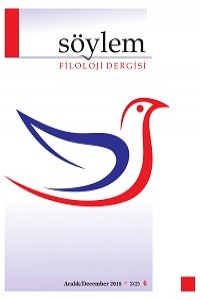Öz
Cemil
Kavukçu, one of the most important names of Turkish storytelling after 1980,
generally focuses on the daily problems while establishing his stories. Some
parts of the stories shaped around daily routines are suitable for expanding
their meaning areas. The first three stories that constitute the chapter
"Kalan" of the book "Düşkaçıran" show a similar feature and
widen the framework of ordinary issues they deal with, with the philosophical
depth that is open to interpretation. There is a line which moves from plural
to single, from society to self in the stories of "İki Nokta Üst
Üste", "Doç", "İkizler". This study will be focused on
the transformation process of Fatih who is the main character of all three
stories and the conflict of self, other and society which reveals in this
transformation process. The state of isolation in the process will be evaluated
around the time and space phenomena with the arguments of Ortega y Gasset in
his book Man and People.
Anahtar Kelimeler
Kaynakça
- Kavukçu, C., Düşkaçıran, Can Yayınları, İstanbul: 2012.Gasset, O., İnsan ve Herkes, Çev. Neyire Gül Işık, Metis Yayınları, İstanbul: 2014.
Öz
1980
sonrası Türk öykücülüğünün önemli isimlerinden Cemil Kavukçu, hikayelerini inşa
ederken genellikle gündelik problemlere odaklanır. Gündelik problemlerin
etrafında şekillenen bu hikayelerin bir kısmı anlam alanlarını genişletmeye
müsait yapıdadırlar. “Düşkaçıran” isimli öykü kitabının “Kalan” bölümünü
oluşturan ilk üç hikaye de benzer bir özellik göstermekte ve ele aldığı sıradan
meselelerin çerçevesini yoruma açık felsefi derinliği ile birlikte
genişletmektedir. "İki Nokta Üst Üste",
"Doç" ve "İkizler" ismini taşıyan bu üç hikayenin çokluktan
tekliğe, toplumdan benliğe doğru ilerleyen bir çizgisi söz konusudur. Her üç
hikayenin de merkezinde yer alan Fatih karakterinin yaşadığı dönüşüm ve bu
dönüşüm sürecinde ortaya çıkan ben, öteki ve toplum çatışması çalışmamızın ana
eksenini oluşturacaktır. Süreç içerisinde gelinen yalnızlaşma durumu, Ortega y
Gasset'nin "İnsan ve Herkes" adlı eserinde ortaya koyduğu argümanlar
ile zaman ve mekan olguları etrafında değerlendirilecektir.
Anahtar Kelimeler
Kaynakça
- Kavukçu, C., Düşkaçıran, Can Yayınları, İstanbul: 2012.Gasset, O., İnsan ve Herkes, Çev. Neyire Gül Işık, Metis Yayınları, İstanbul: 2014.
Ayrıntılar
| Birincil Dil | Türkçe |
|---|---|
| Konular | Sanat ve Edebiyat |
| Bölüm | ARAŞTIRMA MAKALELERİ (TÜRKÇE ) |
| Yazarlar | |
| Yayımlanma Tarihi | 30 Aralık 2018 |
| Gönderilme Tarihi | 29 Ekim 2018 |
| Kabul Tarihi | 2 Aralık 2018 |
| Yayımlandığı Sayı | Yıl 2018 Cilt: 3 Sayı: 2 |

This work is licensed under a Creative Commons Attribution-NonCommercial-NoDerivatives 4.0 International License.


